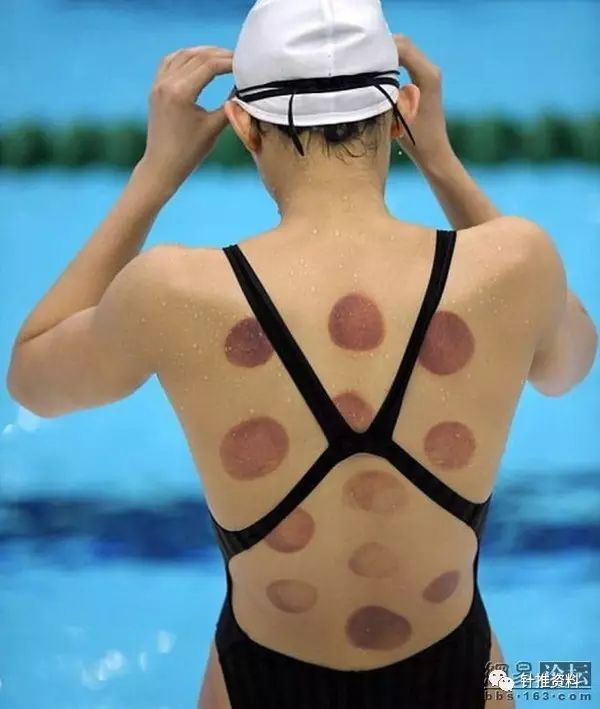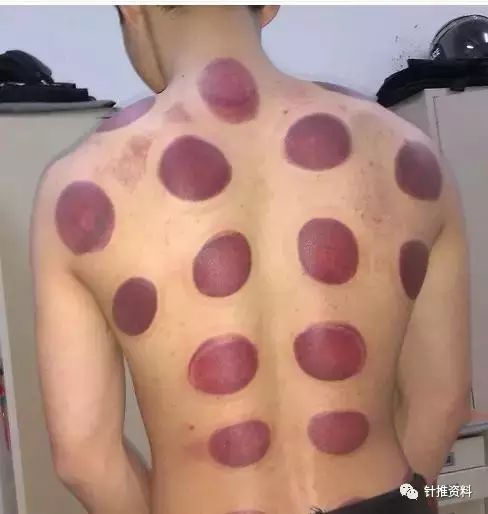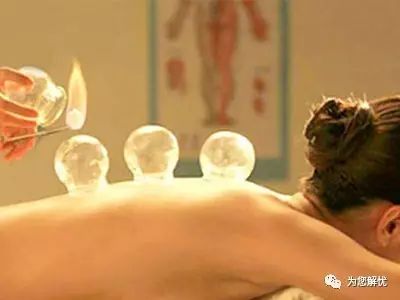
Special Reminder:QQ Group: 311963258, please indicate “Receive Materials” when joining to get free access to “Orthopedic Acupuncture Training Videos” and a collection of medical e-books; Registration hotline: 18511248167, personal WeChat is also this number, welcome to add for timely communication and to receive information about free public courses from Zhongzhui! Click the blue text below the article title to read more articles for free; click the top right corner “…” to quickly share this article.
Cupping marks in the lung area:
1. Purple-red spots appearing on both sides during cupping indicate bronchitis.
2. Red patches appearing during cupping indicate lung heat, with symptoms such as thirst and chest pain.
3. Small rashes appearing during cupping indicate respiratory issues, such as pharyngitis or rhinitis.
4. Light purple or red indicates tonsillitis.
5. Light purple or red indicates lymphatic swelling.
6. White indicates lung deficiency.
7. Enlarged pores indicate wind invasion, exposure to wind and cold. Symptoms may include neck stiffness, scapular pain, or accompanying shoulder periarthritis.
Observations of cupping marks, impressions, shapes, and colors:
1. Dark purple-black cupping marks indicate blood stasis, such as menstrual obstruction, dysmenorrhea, or insufficient cardiac blood supply. If the affected area is severely cold, or if the marks do not fade after several days, it indicates a prolonged illness. If large areas of black-purple marks appear, it suggests significant wind-cold invasion, and treatment should focus on dispelling cold and expelling pathogens.
2. Purple cupping marks with patches generally indicate cold accumulation and blood stasis.
3. Cupping marks with scattered purple spots of varying depths indicate qi stagnation and blood stasis.
4. Light purple with blue patches indicates blood issues, accompanied by blood stasis; if it appears at the kidney shu point (Shenshu), it suggests kidney deficiency; if at the spleen shu point (Pishu), it indicates blood stasis.
5. Bright red cupping marks generally indicate yin deficiency, with both qi and yin deficiency.
6. No cupping marks, or if they appear and immediately fade back to normal color, indicates a mild condition.
7. If cupping results in pink color with no spots, and the skin color returns immediately, it indicates no disease.
Note:
Normal diagnostic colors: pink
Liver and gallbladder: slightly blue
Lungs and intestines: slightly white
Bladder and kidneys: slightly black are all normal
Heart: slightly red
Spleen and stomach: slightly yellow

Cupping marks in the heart area:
1. Purple-red marks connected vertically during cupping indicate obstruction in the heart meridian, which may present with symptoms such as chest tightness and shortness of breath.
2. Small patches during cupping indicate insufficient blood supply to the brain, with symptoms like dizziness and a feeling of numbness in the head.
3. Purple-red stripes during cupping indicate cervical spine issues.
4. White marks indicate myocardial ischemia.
5. Large open pores with mist indicate rheumatic heart disease.
6. White indicates qi and blood deficiency.
7. Depressed marks indicate insufficient heart blood, weak pulse, and shortness of breath.
8. Red marks indicate excessive heart fire.
Cupping marks in the gallbladder area:
1. Depressed small pits during cupping indicate gallstones.
2. Purple spots around indicate dysfunction in gallbladder excretion, which may present with symptoms such as bitter mouth, rib pain, and jaundice.
3. White indicates low gallbladder function.
4. Light purple circles indicate fear and timidity.
5. Patchy red rashes indicate cholecystitis.

Cupping marks in the liver area:
1. Bright red rashes during cupping indicate liver meridian excess heat, which may present with symptoms such as headaches, irritability, flushed face, yellow urine, and dry stools.
2. Blue marks in the center during cupping indicate hepatitis.
3. Light purple circles around indicate qi stagnation due to anger.
4. Purple circles around indicate fatty liver.
5. Large areas of red indicate alcoholic liver disease.
6. Entire liver area appearing purple or purple-red indicates high blood viscosity.
7. Purple-blue and stiff marks indicate liver cirrhosis.
8. Purple-blue spots with white interspersed may indicate ascites.

Cupping marks in the spleen area:
1. Red rashes during cupping indicate poor appetite or fullness in the ribs after eating, with possible symptoms of dizziness and fatigue.
2. Purple and raised marks indicate signs of spleen enlargement, accompanied by irritability and unstable temperament.
3. Red or pink marks with enlarged pores indicate spleen damp-heat, with symptoms of chills and spontaneous sweating.
4. Depressed marks indicate poor spleen function, weakness, slow movement, and reluctance to speak.
5. Light purple or purple circles indicate qi stagnation and frequent irritability.
6. Entire area appearing purple or purple-red indicates high blood lipids and viscosity, possibly accompanied by high blood pressure.
Cupping marks in the stomach area:
1. Red patches during cupping indicate stomach issues.
2. White in the center indicates stomach cold, suggesting stomach pain that worsens with cold.
3. Red marks indicate excessive heat, poor appetite, and food accumulation.
4. Light purple circles indicate anger.
5. Light purple circles around indicate superficial gastritis.
6. Dark purple circles indicate chronic gastritis.
7. Depressed marks with light purple indicate atrophic gastritis.
8. Depressed marks with gray-white indicate poor stomach function and slow peristalsis, with reduced appetite and abnormal stools.
Cupping marks in the large intestine area:
1. Purple-red cupping marks indicate heat in the large intestine, possibly leading to dry stools or symptoms like bad breath and dizziness.
2. Light purple circles indicate retained stool and dryness in the large intestine.
3. White marks indicate wind-cold invasion, primarily in the abdomen.
4. Red marks with enlarged pores indicate large intestine damp-heat, poor digestion, frequent stools, or rapid bowel movements after meals.
5. Gray-white marks with depressed areas indicate slow large intestine peristalsis, possibly leading to constipation for three to five days.
6. Red spots indicate enteritis; purple spots indicate chronic enteritis; light purple spots indicate a history of enteritis.
Cupping marks in the small intestine area:
1. Purple-red spots during cupping indicate small intestine dysfunction, primarily presenting as abnormal bowel movements, abdominal cramps, and bloating.
2. White marks with enlarged pores indicate wind-cold invasion, primarily in the abdomen, accompanied by bowel sounds and gas.
3. Gray-white marks with depressed areas indicate slow small intestine peristalsis.
4. Purple spots indicate enteritis.
5. Dark red circles indicate ulcer points.
6. Dark purple spots indicate toxins in the intestines.
7. Light purple spots indicate previous inflammation.
8. Dark purple circles around indicate constipation and retained stool.
Cupping marks in the kidney area:
1. Purple spots during cupping indicate kidney qi instability, such as chronic nephritis, with frequent clear urination, nocturia, and lower back pain.
2. White marks indicate kidney deficiency with water retention, severe swelling below the waist, reduced urine output, and in severe cases, abdominal distension and scrotal swelling.
3. Depressed small pits indicate granular kidney stones; if white sandy particles are present, it indicates gravel-like kidney stones.
4. Enlarged pores that do not fade indicate wind-cold in the left kidney, while the right kidney indicates rheumatism in the hip joints.
5. Purple spots indicate past injuries to the lower back, such as sprains, bruises, or various external injuries.
6. Internal purple or light purple circles indicate water retention in the kidneys.
7. Significant color contrast between the two kidneys, such as purple-red in the left kidney and gray-white in the right kidney, indicates uncoordinated kidney function, with excess yang and deficient yin, or vice versa.
8. Entire kidneys appearing purple-red with a hard protrusion indicate hyperfunction.
Cupping marks in the bladder area:
1. Dark red bruises during cupping in males indicate prostatitis, frequent urination, urgency, painful urination, or difficulty urinating, with cloudy urine; in females, it indicates menstrual irregularities and other gynecological diseases.
2. Purple-red patches with dull color in males indicate prostate enlargement, while in females, it indicates cervical erosion.
3. Purple-red spots in the lower area indicate hemorrhoids.
4. If the outer circle is white and the inner circle is light purple, it indicates signs of diabetes; if the middle is red, it indicates current exacerbation, with at least two symptoms present.
5. Peeling skin indicates chronic diabetes symptoms.
6. Entire cupping area appearing gray-white with depressed areas indicates reduced sexual function.
7. Irregular light purple circles indicate past trauma and kidney dysfunction.
8. Dark purple spots in females indicate gynecological diseases, with the upper area indicating uterine issues and the upper diagonal areas indicating appendage or ovarian diseases.
9. Light purple spots in females indicate uterine fibroids.
Note: Leave the cups on for 5-6 minutes, then assess the skin based on the cupping results; this method is based on clinical experience and should not be used as a theoretical basis.


